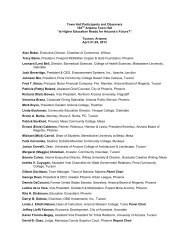Background Report - Arizona Town Hall
Background Report - Arizona Town Hall
Background Report - Arizona Town Hall
You also want an ePaper? Increase the reach of your titles
YUMPU automatically turns print PDFs into web optimized ePapers that Google loves.
Appendix B:<br />
Poetry and Art: Information and Biographies<br />
The art works that appear on the front and back covers, as well as those reproduced within<br />
the report, reference broader issues that transcend the <strong>Arizona</strong>’s cultural community.<br />
Janet Echelman’s Her Secret is Patience (2009), on the cover, speaks to <strong>Arizona</strong>’s national<br />
leadership in the realm of public art. It is a signature piece of an ambitious vision for the<br />
revitalization Phoenix’s downtown, bolstered by ASU’s downtown campus and the light rail<br />
system, which opened in December 2008. On the back cover is a work by Matthew Moore.<br />
He is the last of four generations of farmers in the West Valley, and his “Urban Plough” series<br />
suggest the collision of suburban expansion and development with the state’s traditional<br />
agricultural base. The photograph by Mark Klett and Byron Wolfe references a rich landscape<br />
history, as well as the fact that with the Santa Fe Railway and the Fred Harvey Company, it<br />
was artists who helped both to make the Grand Canyon grand and to sell the Southwest to<br />
cultural tourists. Tiffiney Yazzie is a young Navajo photographer, and her image of a shelf of<br />
books on Navajo culture records what are widely regarded as important publications on<br />
the subject, but whose authors are are largely White. D. Bryon Darby dramatically visualizes<br />
the dynamic growth of <strong>Arizona</strong>’s transportation hubs in his riveting image of seventy<br />
flights landing at Sky Harbor Airport in a ninety-minute time span. The tile mural by<br />
Cristina Cárdenas of Tucson is embedded in a long tradition of Latina art in the state of<br />
<strong>Arizona</strong> and has deep links to the Mexican muralists. Cowboy poetry by Carole Jarvis<br />
and Scott Baxter’s photograph of Sam Udall at the Y Cross Ranch references an important<br />
part of <strong>Arizona</strong>’s heritage.<br />
Scott T. Baxter has been a professional photographer for over twenty-five years. His<br />
documentary projects include photographing the indigenous peoples of Chiapas, Mexico.<br />
Project Statement: “100 Years 100 Ranchers” coincides with <strong>Arizona</strong>’s 2012 Centennial and<br />
documents 100 <strong>Arizona</strong> ranchers whose families have been ranching in <strong>Arizona</strong> since 1912<br />
or earlier. I have always been drawn to people. Regardless of the setting, the human element<br />
in a photograph will always give one a sense of place and perspective. The ranching tradition<br />
in <strong>Arizona</strong> is enduring and important, even more so as conditions such as encroaching<br />
development, drought, and dire economic conditions have made a difficult way of life even<br />
more tenuous. Disputes over water rights, grazing fees, and recreation have also deeply<br />
affected the ranching way of life. The intense demanding work involved in running a ranch<br />
has led some children to choose not to stay on and pursue this life. Ranchers love what they<br />
do, and cherish the land and tradition that has been passed down to them through their f<br />
amilies. My goal is to recognize the families that have struggled to survive and persevere in<br />
these challenging times. As ranches are lost to developers and poor economic conditions, my<br />
work preserves photographically an integral part of <strong>Arizona</strong>’s tradition and history. I work<br />
with black and white large format film as a monochromatic study effectively portrays the<br />
spirit of this unique group of <strong>Arizona</strong>ns. Working with large and medium format film slows<br />
down the process and allows me to engage my subjects in a more personal, less detached<br />
manner. I travel to each rancher’s headquarters in order to get to know each individual and<br />
their operations.<br />
242 | Appendix




